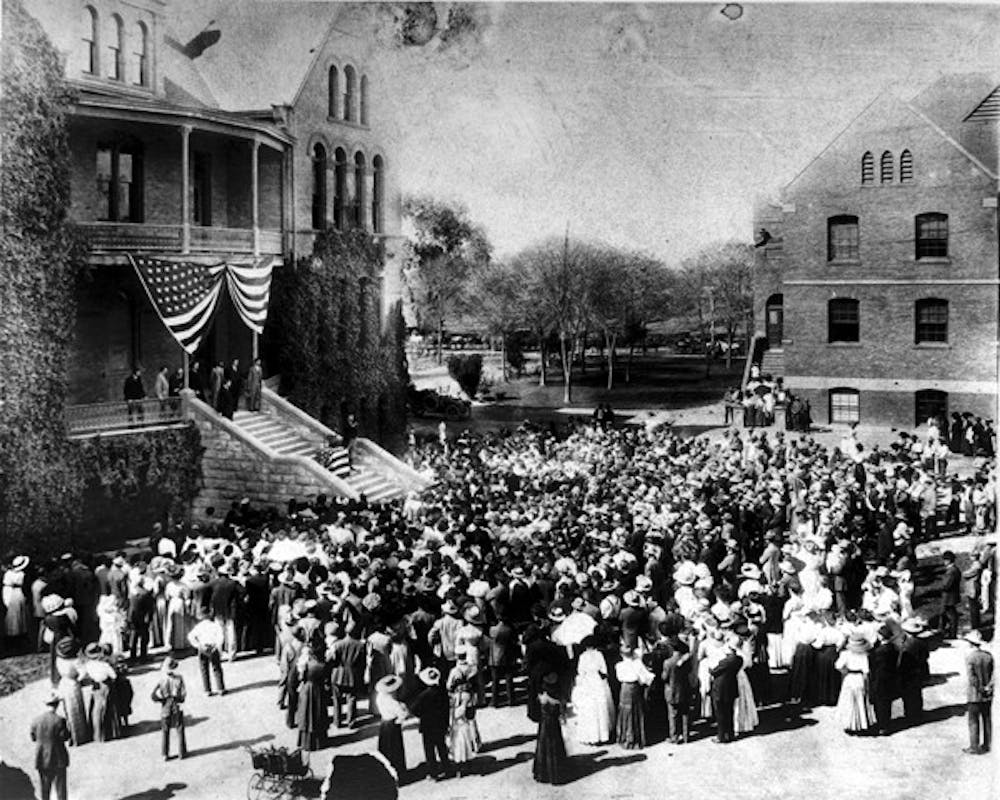Vestiges of what ASU looked like on the day Arizona became a state can still be seen today.
Only three of the eight buildings that made up the Tempe Normal School of Arizona in 1912 remain on the Tempe campus.
Old Main, then known as the Main Building; the Virginia G. Piper Writers House , then known as the President’s Cottage; and the University Club, then known as the Science Building, are still standing.
Architecture professor Thomas Morton said the three remaining buildings from 1912 show architectural differences.
“You’re looking at a range of 15-20 years,” he said. “There’s some variation there.”
He said there was a sense of “architectural dialogue” between Old Main, built in 1898, and the University Club, built in 1908. Both buildings are reached by a staircase and are largely composed of two wings around a central block.
History professor Philip Vandermeer said the school represented the area it was in. In 1898, it was one of three buildings allocated by the territory.
The state’s first university was built in Tucson, a mental health facility went to Phoenix and a normal school, or teacher’s college, went to Tempe, which was a small agricultural community.
“Basically, (the Normal School was) a developing institution,” Vandermeer said.
In addition to the classrooms and dormitories, a school attended by about 175 children served as a training laboratory for the Normal School students aspiring to be teachers.
Though no modern degrees were offered at the Normal School, students had the choice to enroll in either a professional program — earning a diploma and teaching certificate that could be used in Arizona and California — or another program earning only a diploma, University Archivist Rob Spindler said.
“It was a long ride on horseback to get a university degree,” Spindler said. “This was the only form of higher education for 100 miles.”
He said the school’s demographics were also different.
Most of the 267 students enrolled in the Normal School in the fall of 1911 were Anglo-Saxon women from privileged families, Spindler said.
Students paid about $188.50 in total expenses for a year, which, adjusted for inflation, comes out to about $4,200 today, Spindler said.
Their activities were also different. Sports were still important to the campus, but the Normal School, like many schools nationwide, was in the middle of a hiatus from football.
Between 1905 and 1913, the Normal School did not play football because there were nineteen fatalities in 1905 across the country.
Instead, the school’s main sport was baseball, which went 13-4 in 1912.
The 1912 baseball team had no scholarships for athletics and barely any uniforms — let alone merchandising.
“They were lucky to scrape up enough guys to play,” Spindler said.
1912 was the first year that men’s basketball played, while women’s basketball had been playing competitively for more than a decade.
In addition to watching sporting events, students would end their long days at school with meetings of educational societies.
“One of the most popular things to do was join a literary society,” Spindler said. “Writing and literary reviews were important to these students.”
Despite their differences, the Normal School of 1912 and ASU of 2012 had similarities.
“Both struggled with assisting students who had received different levels of education,” Spindler said.
Students at the Normal School could have received anything from an eighth grade education to some college. It therefore took students a different amount of time to graduate.
While all students at ASU today need to have a high school education or the equivalent, high schools differ in the quality of the education conferred and the University still has to offer remedial courses in some subjects, Spindler said.
He said students and the administration have also perennially tried to secure adequate funding for the school.
“This institution has always struggled to keep up with the growth of Arizona,” Spindler said. “It’s important for students to understand how far we’ve come in such a short period of time.”
Reach the reporter at julia.shumway@asu.edu or follow @JMShumway on Twitter.
Like The State Press on Facebook and follow @statepress on Twitter.




